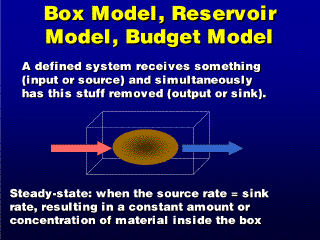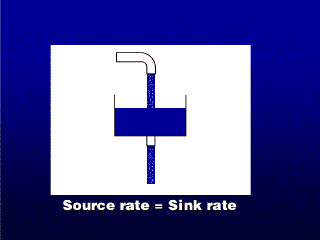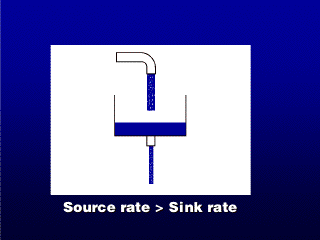 To get dosages and exposures, we need to find the concentration
of pollutants in the atmosphere. We define a specific volume---the
box---in which pollutants mix. Then we see that sink
processes result in a continuous removal of pollutants while emissions are
continuous sources of the pollutant.
If the source rate is the same as the
sink rate, then the concentration of pollutant in the box should remain constant
(because the absolute amount of pollutant inside the box is constant when source=sink).
This steady-state concentration will be the concentration of pollutant
used to determine health effects from a particular source or emission rate.
To get dosages and exposures, we need to find the concentration
of pollutants in the atmosphere. We define a specific volume---the
box---in which pollutants mix. Then we see that sink
processes result in a continuous removal of pollutants while emissions are
continuous sources of the pollutant.
If the source rate is the same as the
sink rate, then the concentration of pollutant in the box should remain constant
(because the absolute amount of pollutant inside the box is constant when source=sink).
This steady-state concentration will be the concentration of pollutant
used to determine health effects from a particular source or emission rate.
In real-life situations, the sink
rate is not necessarily equal to the source rate at any one time, so the concentration
will not be steady-state. However, since the absolute sink rate usually has
some dependence on the current concentration of the pollutant in the box (generally,
the higher the concentration, the higher the absolute sink rate), there may
be a natural tendency for the concentration to change so that the sink rate
changes until it is equal to the source rate, at which point we will achieve
equilibrium.
 This
is an example of a steady-state box system. The basin is being filled with water
from a faucet (rate of water flow is the source rate) while water drains out
the bottom (rate of water flow here is the sink rate). As long as the rate at
which water drains out is the same as the rate water flows in, the level of
the water in the basin will remain constant.
This
is an example of a steady-state box system. The basin is being filled with water
from a faucet (rate of water flow is the source rate) while water drains out
the bottom (rate of water flow here is the sink rate). As long as the rate at
which water drains out is the same as the rate water flows in, the level of
the water in the basin will remain constant.
 This shows a box system where the flow of water in exceeds the flow of water
out. This box will not be in steady-state; the level of the water in the basin
goes up as time passes. In a real-world situation, the rate of water flow out
the drain will be proportional to the level of water in the basin (the pressure
from the deepening water forces more water out the drain as the water level
rises), so there may be a point where the water flow rate out equals the (constant)
inflow rate, at which time the level of the water in the basin becomes constant.
This would demonstrate that many natural box or reservoir systems tend to natural
gravitate toward a steady-state configuration, which is why the steady-state
box model is so important to study.
This shows a box system where the flow of water in exceeds the flow of water
out. This box will not be in steady-state; the level of the water in the basin
goes up as time passes. In a real-world situation, the rate of water flow out
the drain will be proportional to the level of water in the basin (the pressure
from the deepening water forces more water out the drain as the water level
rises), so there may be a point where the water flow rate out equals the (constant)
inflow rate, at which time the level of the water in the basin becomes constant.
This would demonstrate that many natural box or reservoir systems tend to natural
gravitate toward a steady-state configuration, which is why the steady-state
box model is so important to study.


 To get dosages and exposures, we need to find the concentration
of pollutants in the atmosphere. We define a specific volume---the
box---in which pollutants mix. Then we see that sink
processes result in a continuous removal of pollutants while emissions are
continuous sources of the pollutant.
If the source rate is the same as the
sink rate, then the concentration of pollutant in the box should remain constant
(because the absolute amount of pollutant inside the box is constant when source=sink).
This steady-state concentration will be the concentration of pollutant
used to determine health effects from a particular source or emission rate.
To get dosages and exposures, we need to find the concentration
of pollutants in the atmosphere. We define a specific volume---the
box---in which pollutants mix. Then we see that sink
processes result in a continuous removal of pollutants while emissions are
continuous sources of the pollutant.
If the source rate is the same as the
sink rate, then the concentration of pollutant in the box should remain constant
(because the absolute amount of pollutant inside the box is constant when source=sink).
This steady-state concentration will be the concentration of pollutant
used to determine health effects from a particular source or emission rate. This
is an example of a steady-state box system. The basin is being filled with water
from a faucet (rate of water flow is the source rate) while water drains out
the bottom (rate of water flow here is the sink rate). As long as the rate at
which water drains out is the same as the rate water flows in, the level of
the water in the basin will remain constant.
This
is an example of a steady-state box system. The basin is being filled with water
from a faucet (rate of water flow is the source rate) while water drains out
the bottom (rate of water flow here is the sink rate). As long as the rate at
which water drains out is the same as the rate water flows in, the level of
the water in the basin will remain constant. This shows a box system where the flow of water in exceeds the flow of water
out. This box will not be in steady-state; the level of the water in the basin
goes up as time passes. In a real-world situation, the rate of water flow out
the drain will be proportional to the level of water in the basin (the pressure
from the deepening water forces more water out the drain as the water level
rises), so there may be a point where the water flow rate out equals the (constant)
inflow rate, at which time the level of the water in the basin becomes constant.
This would demonstrate that many natural box or reservoir systems tend to natural
gravitate toward a steady-state configuration, which is why the steady-state
box model is so important to study.
This shows a box system where the flow of water in exceeds the flow of water
out. This box will not be in steady-state; the level of the water in the basin
goes up as time passes. In a real-world situation, the rate of water flow out
the drain will be proportional to the level of water in the basin (the pressure
from the deepening water forces more water out the drain as the water level
rises), so there may be a point where the water flow rate out equals the (constant)
inflow rate, at which time the level of the water in the basin becomes constant.
This would demonstrate that many natural box or reservoir systems tend to natural
gravitate toward a steady-state configuration, which is why the steady-state
box model is so important to study.